 Hi Everyone,
Hi Everyone,
NOTES:
* I read several comments from people in Texas who went without power and supplies. One of them made a list of things they wish they had and things they were thankful that they DID have. That information is attached below. Spelling and grammar are original.
* I also saw THIS image:
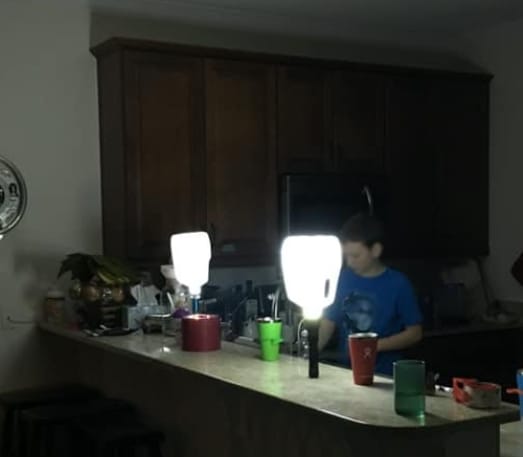
I thought this was a good idea. The milk cartons diffuse the light from the flashlights to create more light.
We have maybe 2 dozen outside solar lights in our yard. In an emergency, we could just bring them inside at night.
A 100+ Hour candle or a Kerosene Lantern might be a good investment.
* How will you charge your cell phones with no power? You can always sit in the car and charge it there. But that will be about 1/2 an hour of going nowhere just to charge your phone. I have some of these: Solar Power Bank Portable Charger 20000mah Waterproof Battery Backup Charger Solar Panel Charger with Dual LED Flashlights and Compass for iPhone Android CellPhones. There are several different brands, most about $25 more or less. What I like about them is you can recharge them with the sun. It will take about 1/2 an hour to charge your phone and about 4-5 hours to recharge the battery. Solar power works SLOWLY!!!
* You can buy larger solar cells for a little more money. Solar Panel Travel, Nekteck 21W Solar Charger, IPX4 Waterproof Portable Camping Gear Solar Powered Charger with 2 USB Port Compatible with iPhone, iPad, Samsung Galaxy S, and Any USB Devices. The difference between this and the portable charger is that this does not have a battery. You can only charge when the sun is shining. The smaller one can charge during the day, and you can use it at night because it stores the power in a battery.
* I couldn’t help myself and planted most of my garden last week, including the tomatoes, peppers, cucumbers, and all the warm, loving vegetables. Today I looked at the weather and saw that the night temps would get low in a few days. Watch, watch, watch, and be prepared to cover them up if the weather predicts less than 37. Give yourself a 5-degree leeway.
LONG TERM FOCUS: Beans & Legumes
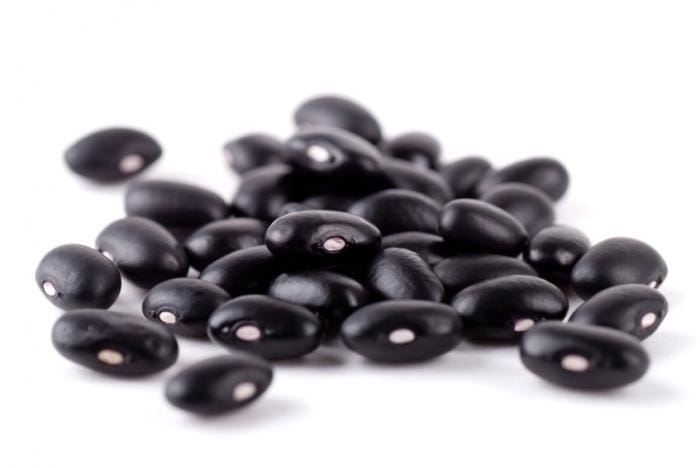
Did you know you can substitute black beans for oil and butter in desserts? Legumes have a wonderful way of keeping desserts moist and chewy while cutting back on calories and adding fiber and protein. (Black Bean Brownies, by Leigh Zaleski at ydr.com) Pureed beans can be substituted for oil or butter or flour. The recipe for brownies using black beans is below. Just a note. I tried this. BUT, my blender did not blend as fine as I would have liked. Don’t get me wrong. The brownies “tasted” wonderful!!! BUT, there were bits of bean skins that didn’t get blended enough, and I couldn’t get past the texture. I have a better blender now and might try this again.
When you substitute beans, use a 1:1 ratio if the recipe calls for 1 c. butter, use 1 c. beans instead. Be sure to match the beans to the color of the baked goods. Brownies: black beans. White cake: white beans.
SHORT TERM FOCUS
If there is no water, it makes it difficult to clean dishes. A pack or two of paper plates and cups would be a good thing to include. Find a place in the garage to keep them – just in case.
MISC. FOCUS: Getting Clean Water
There are three ways to make water safe:
 Boil: According to the CDC, Making Water Safe in an Emergency | Water, Sanitation, & Hygiene-related Emergencies & and Outbreaks | Healthy Water boiling is the surest method to kill disease-causing organisms, including viruses bacteria, and parasites. Strain dirty water through a cloth or coffee filter, then boil for 1 minute. Above 6,500 feet, boil for 3 minutes. Let cool.
Boil: According to the CDC, Making Water Safe in an Emergency | Water, Sanitation, & Hygiene-related Emergencies & and Outbreaks | Healthy Water boiling is the surest method to kill disease-causing organisms, including viruses bacteria, and parasites. Strain dirty water through a cloth or coffee filter, then boil for 1 minute. Above 6,500 feet, boil for 3 minutes. Let cool.
There are several YouTube videos about distilling water at home on your stove or over a campfire. I did it once at school. I used a large container of very dirty water (I let the kids add the dirt and trash. LOL), then I covered it with some Saran Wrap and placed a small rock in the middle so that as the water evaporated, it would drip down the center of the plastic wrap and into a clean cup. We just put it in the sun and let it evaporate. No fuel is needed.- Add disinfectant: You can use bleach. For one quart, add 10 drops. One gallon, add 40 drops. (1/2 tsp), and for 5 gallons, add 2 1/2 tsp bleach. Stir and let stand for 30 minutes before drinking. You can get these: Potable Aqua Germicidal Water Purification Tablets – 50 Count. The bottles are tiny and easy to carry. It takes 2 tablets to purify 1-quart water. This twin pack will purify 50 quarts of water. Follow the directions.
- Filter – The Seychelle filters from last week are an example of this. Berkey filters are expensive but easy to use. You can make your own primitive filter using a 2-liter bottle upside down with the end cut off. In the bottle, layer a coffee filter, some charcoal (fish supplies at Walmart), sand, another filter, small gravel (fish supplies again), and a filter on top. The first batch will come out black because of the charcoal, but it will clear up and actually work pretty well. It’s bulky and not very efficient, but it DOES work.
FOOD STORAGE RECIPES
Boston Baked Beans
This recipe was included in a food storage package that we bought from Perma Pak.
2 c. navy beans. Wash and drain. Cover with cold water and bring to a boil. Let sit for 1-2 hours. Drain. Cover again with 4 c. water, bring to a boil, and simmer, uncovered, for 1-2 hours, or until tender. (Do not boil rapidly, or beans will burst.) Drain, reserving liquid.
Preheat oven to 300 degrees.
Layer beans with 2 TB chopped onions in an ungreased 2-quart casserole dish. Stir together
1/4 c. cooking oil or butter
1/4 c. brown sugar, firmly packed
3 TB molasses or honey
1/4 tsp dry mustard
1/8 tsp pepper
1 c. of the reserved liquid. Mix and pour over beans. Add enough of the remaining reserved liquid or water to almost cover beans. Cover. Bake 3 1/2
Removing the cover and stir in
1/2 c. bacon-flavored TVP, or chopped fried bacon. Continue baking uncovered for 30 more minutes.
Black Bean Brownies
From the article: Black Bean Brownies: Substitute beans for butter, oil
By Leigh Zaleski at ydr.com
2 cans of black beans rinsed and drained. Add to a food processor with 1/4 c. water and puree for about 1 minute or until smooth.
Transfer puree to a large bowl and add:
1 c. sugar
6 TB Stevia (1 c. sugar)
1/2 c. skim milk
1 tsp vanilla
1 1/2 c. whole wheat flour
1/2 c. dark chocolate unsweetened cocoa
1 tsp salt
1 tsp baking powder
1 tsp baking soda
1 c. dark chocolate chips
Spray 13 X 9 inch pan with cooking spray. Pour batter into pan.
Bake 350 degrees for 35-45 minutes, or until a toothpick comes out clean.
Healthy Flourless Chocolate Cake
It makes one 9″ layer cake.
Preheat oven to 325 degrees. Spray a 9″ cake pan with cooking spray or grease with shortening. Dust cocoa all around the inside of the pan. Cut a round of parchment and line the bottom of the pan. Spray the parchment lightly.
1 15-oz can unseasoned black beans Drain and rinse.
OR 1 1/2 c. cooked beans, any color, drained and rinsed.
Place beans and…
3 large eggs
1 TB vanilla
1 tsp stevia extract (1/2 c. sugar)
1 tsp salt
into a blender. Blend on high until beans are completely liquefied.
In a separate dish, beat…
6 TB butter
1/2 c. honey (or 2/3 c. sugar) until light and fluffy. Add
2 eggs, beating for 1 minute after each addition.
Add bean batter and mix.
Stir in…
6 TB unsweetened cocoa powder
1 tsp baking powder
1/2 tsp baking soda and beat on high until smooth.
Scrape into pan. Tap on the counter to release any air bubbles
Bake 40-45 minutes. Cool 10 min. Turn out cake from pan. For the best flavor, let sit overnight.
Don’t be caught, not prepared. Please don’t put it off. Do something—–soon!!!
Marti
Texas Storm List:
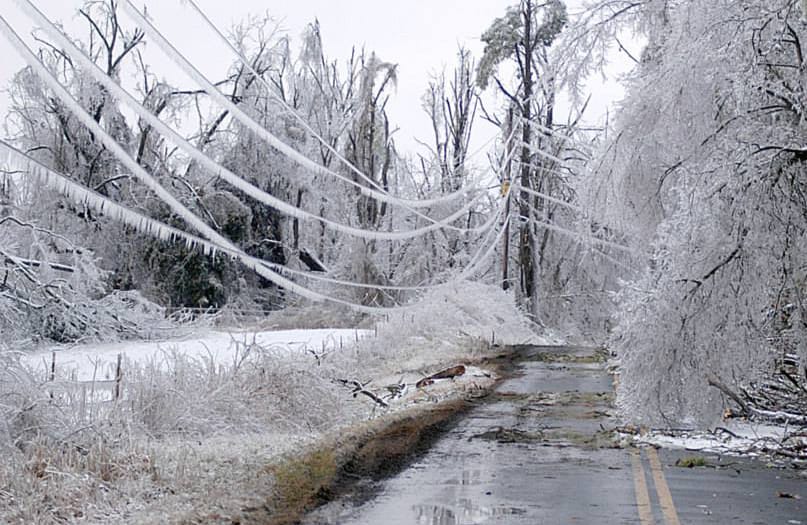 Many of you are aware of the situation in Texas, but I thought I’d share a couple of things I am grateful we’ve had on hand here in TEXAS. Our town was like the Whos on the show Horton Hears a Who. We were on the rolling blackout schedule at first. Then they dropped our border town, saying we didn’t need help… There is a natural spring in town. Our town’s water plant required electricity to run and had no backup generator. What a blessing to have the creek for those that needed it. Then toilets backed up into it, contaminating it because the processing plant also relied on power and was overflowing into it. Parts of our town were without power for days with no water. We couldn’t do the dishes and couldn’t wash clothing. Everything in our freezer thawed even though it was cold in our home. Our children loved this ‘glamping’ experience, and we did well, but many of our neighbors were mentally and physically not okay. Our town distributed bottled water the best they could, and we didn’t need to take any so others could be okay. The town also opened up the swimming pool so everyone could haul water for plumbing. They also provided free meals to those that could get to them. Pipes burst for many. Windows aren’t insulated in many homes. Roads were never cleared (no way to do it).
Many of you are aware of the situation in Texas, but I thought I’d share a couple of things I am grateful we’ve had on hand here in TEXAS. Our town was like the Whos on the show Horton Hears a Who. We were on the rolling blackout schedule at first. Then they dropped our border town, saying we didn’t need help… There is a natural spring in town. Our town’s water plant required electricity to run and had no backup generator. What a blessing to have the creek for those that needed it. Then toilets backed up into it, contaminating it because the processing plant also relied on power and was overflowing into it. Parts of our town were without power for days with no water. We couldn’t do the dishes and couldn’t wash clothing. Everything in our freezer thawed even though it was cold in our home. Our children loved this ‘glamping’ experience, and we did well, but many of our neighbors were mentally and physically not okay. Our town distributed bottled water the best they could, and we didn’t need to take any so others could be okay. The town also opened up the swimming pool so everyone could haul water for plumbing. They also provided free meals to those that could get to them. Pipes burst for many. Windows aren’t insulated in many homes. Roads were never cleared (no way to do it).
What I’m grateful we had:
- Zip ties
- Pushpins to secure blankets over windows when power was out
- Berkey water filtration system
- Gas range (burners work with lighter, the stove didn’t work as it was electric we didn’t know that was a thing to put gas burners and electric underneath–had no way to start it without power)
- Disposable plates and utensils
- Candles/flashlights
- Empty buckets
- Plastic garbage bags
- Plastic store bags to shove in cracks of doorways to keep cold out best we could
- Tape
- Food to eat that required nothing extra (we need more variety in the future)
- Can opener
- Books- we homeschool, and my husband reads to the family at night. Adding candlelight was magical.
Large Cooler - Craft supplies and games (we don’t let the children play on devices, but they do watch movies, but they didn’t ask once for one as this was too much fun for them)
- Inviting friends in as it was warmer together
- Peace of mind–we were ok. We have holes and ways to improve, but these things were necessary.
A couple of things that would have been more comfortable:
- Generator and small portable heater
- Clean home to begin with– we just moved and have boxes of things to unpack still, our laundry was backed up–washer and dryer both had wet clothing in them when the power went out, dishes hadn’t been fully done when the power went out.
- We have 5 children, 7 and under, two adults, and a dog.
This isn’t over, and we might lose power and water again, but for the last 12 hours we’ve had these things back, we have been counting our blessings. There is more to add, I’m sure, but here is a start.


 Boil: According to the CDC,
Boil: According to the CDC, 
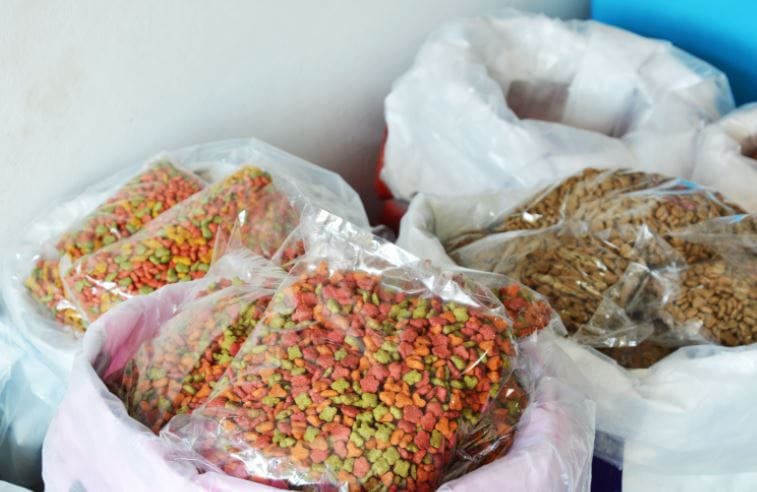 Lentils are legumes – cousins to beans. Lentils can be green, red, yellow, black or brown. They are full of nutrients with no fat and lots of fiber and protein. Lentils cook much faster than dry beans and don’t need to be soaked. To cook, just rinse and boil 3 cups of water to 1 cup of lentils. They are tender in 15-20 minutes.
Lentils are legumes – cousins to beans. Lentils can be green, red, yellow, black or brown. They are full of nutrients with no fat and lots of fiber and protein. Lentils cook much faster than dry beans and don’t need to be soaked. To cook, just rinse and boil 3 cups of water to 1 cup of lentils. They are tender in 15-20 minutes.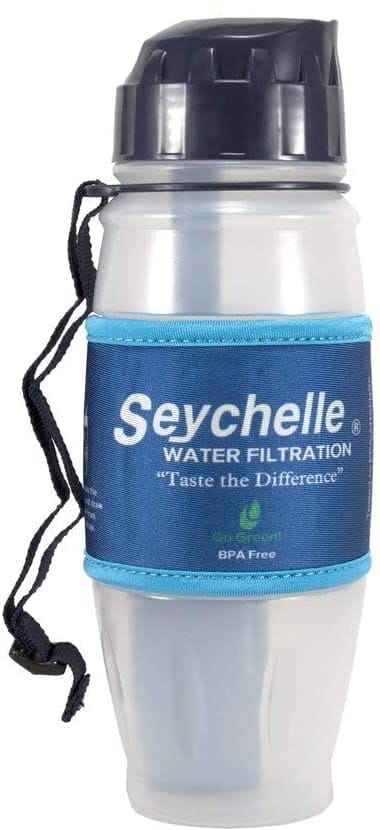

 5-gallons. They are perfect for me because I can move them around (they have handles). Amazon.com :
5-gallons. They are perfect for me because I can move them around (they have handles). Amazon.com : 
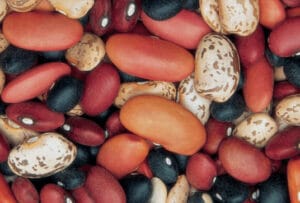 It is recommended that you soak beans before cooking them. They need rehydrating.
It is recommended that you soak beans before cooking them. They need rehydrating.


 You don’t need a testing kit. You just need vinegar and baking soda. The short version is to mix two small samples of soil with distilled water. Add 1 TB of vinegar to one and 1 TB of baking soda to the other.
You don’t need a testing kit. You just need vinegar and baking soda. The short version is to mix two small samples of soil with distilled water. Add 1 TB of vinegar to one and 1 TB of baking soda to the other.



 Hey Everyone!!
Hey Everyone!! Oats are just one choice for storing “whole grains.” Other choices include amaranth, barley, rice, corn (cornmeal, popcorn, etc.), quinoa, rye, spelt, and wheat. Whole grains contain fiber and other nutrients. A good goal is to have 1/2 of the grains you eat be whole grains. “The protein in oats is higher than that in wheat or rice. The protein in oats is nearly equal to meat, milk, and egg protein.” (Food Storage Powerhouse, Orgill, p34) Oats also provide vitamin B1, phosphorus, manganese, biotin, and other vitamins and minerals. This is one reason it’s a good storage choice. If you store oats in an airtight container and use either a dry ice technique, oxygen-absorbing packets, or food-grade diatomaceous earth, the oats will last 30 years or more. If you can store oats inside, in a closet, protected from water or rodents, they will last several years – long enough to rotate them.
Oats are just one choice for storing “whole grains.” Other choices include amaranth, barley, rice, corn (cornmeal, popcorn, etc.), quinoa, rye, spelt, and wheat. Whole grains contain fiber and other nutrients. A good goal is to have 1/2 of the grains you eat be whole grains. “The protein in oats is higher than that in wheat or rice. The protein in oats is nearly equal to meat, milk, and egg protein.” (Food Storage Powerhouse, Orgill, p34) Oats also provide vitamin B1, phosphorus, manganese, biotin, and other vitamins and minerals. This is one reason it’s a good storage choice. If you store oats in an airtight container and use either a dry ice technique, oxygen-absorbing packets, or food-grade diatomaceous earth, the oats will last 30 years or more. If you can store oats inside, in a closet, protected from water or rodents, they will last several years – long enough to rotate them.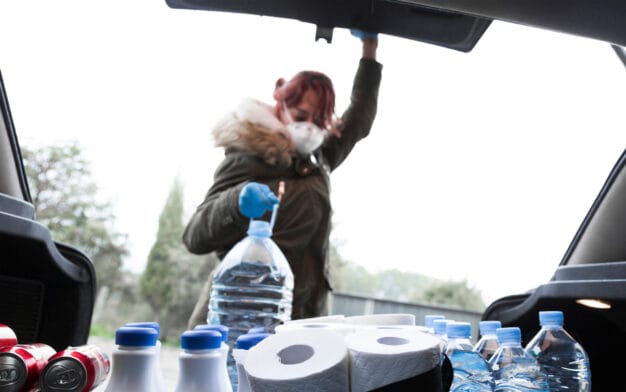 BPA safe. A bigger risk is drinking from a bottle, then letting it sit in a hot car where bacteria can grow. A video on this site shows how the sun can be magnified by the water and burn the upholstery.
BPA safe. A bigger risk is drinking from a bottle, then letting it sit in a hot car where bacteria can grow. A video on this site shows how the sun can be magnified by the water and burn the upholstery.
